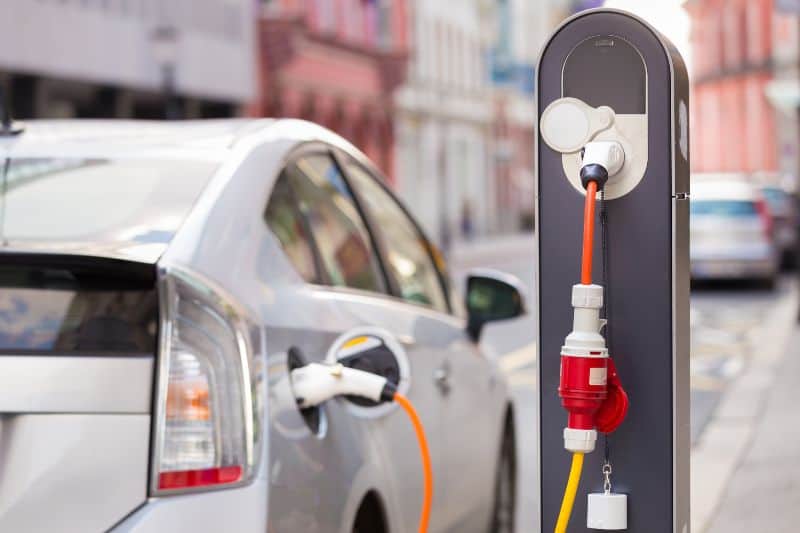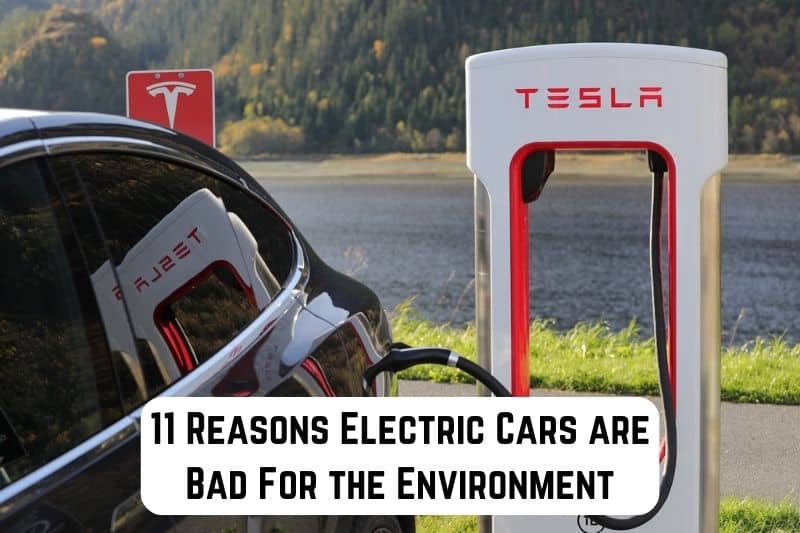While electric vehicles are more environmentally friendly than internal combustion engine vehicles, that doesn’t imply the former are faultless. We are at a turning point in the history of the automobile industry. More diverse production is replacing the conventional internal combustion engine, or ICE, automobile.
This takes the shape of hybrid cars, which blend electric and internal combustion engine technology. Naturally, this also brings us to the hottest new trend, the electric vehicle, or EV, which seems to be slowly melting internal combustion engines.
Even while ICE automobiles still make up the great majority of cars on the road and in sales today, millions of electric vehicles are already sharing the road. While some see EVs as a new way to reduce human pollution on our beautiful planet, others do not think they are as environmentally friendly.
Read: Open-Pit Mining & It’s Environmental Impact
How Does an Electric Car Work?
Electric vehicles (EVs) don’t need internal combustion engines to run, in contrast to gas-powered automobiles. Because they run on electricity rather than gasoline and emit fewer toxic emissions from their exhaust, electric vehicles (EVs) produce less noise pollution and operate on our roads with an electric motor and rechargeable battery pack.
Unlike conventional gas-powered internal combustion engine (ICE) vehicles, electric vehicles (EVs) do not require the explosive combustion of consumed fuel to produce the necessary energy for motion. Instead, they propel the automobile forward by turning the electric motor attached to the wheels using the electrical energy contained in their battery packs.
11 Reasons Why Electric Cars are Bad For the Environment
Many individuals think that driving an electric automobile is better for the environment. Is this a fitting association, though? You might be surprised to learn that EVs have their environmental costs. What drawbacks do electric automobiles have, and what makes them environmentally harmful?
1. The Manufacturing Process
Just like any other car, electric vehicles must be produced. Electric automobiles are produced in enormous quantities today to meet the ever-growing demand, requiring factories, equipment, and other resources. EV manufacturing leaves a significant carbon footprint since it involves a lot of electricity from non-renewable resources.
It’s also crucial to remember that the main component of the EV manufacturing process is the fabrication of batteries. Although we’ll go into greater detail about EV batteries a little later, battery components significantly raise the total energy requirements for an EV compared to a conventional vehicle.
2. EV Batteries Require Rare Metal Extraction
The batteries in electric automobiles are one of its main drawbacks. While there are different types of EV batteries, most EV manufacturers use lithium-ion batteries for their electric vehicles. Evaporation or ore mining are two methods to remove lithium, an elemental metal, from the globe. However, there are environmental effects associated with these two extraction methods.
Lithium is found in salt deserts in some nations, including Argentina. The Salar de Atacama in Chile is one of the salt deserts with the highest lithium content. Lithium is recovered from the seawater of the Atacama Desert via evaporation and is subsequently stored in basins.
However, this is not a risk-free procedure. In addition to requiring energy to run the equipment, evaporation can contaminate and raise the water’s salinity, impacting neighboring communities’ water supply.
3. EV Battery Disposal
Lithium-ion batteries and the environmental risks they present (such as emissions of greenhouse gases, improper disposal, and water contamination) may already be familiar to you. The disposal procedure has raised environmental concerns because many EV companies use lithium-ion batteries.
EV batteries would be bad for the environment if disposed of the same way as regular rubbish, such as wrappings and baby wipes. However, there is a fix for this problem. Since EV batteries can be recycled, their environmental impact is significantly reduced.

4. Tire Emissions
Whether we drive an electric car or a fuel-powered car, the tires and brakes that our cars employ emit pollution. It’s a given that tires eventually wear out and must be replaced. This is because friction releases microscopic particles as tires wear down on the pavement. Sadly, tiny particles are the leading cause of environmental problems.
Emissions Analytics says tire emissions maybe 1,000 times worse than exhaust emissions. Numerous carcinogens, including dibenzopyrenes, are found in tires. Aquatic life may be harmed by these particles when they contaminate water bodies. We are also in danger when they pollute the air we breathe.
5. Brake Emissions
When it comes to brake emissions, things are comparable. The brake pads that line your braking discs wear down with each use of the brakes on your car, releasing particles. The Air Quality Expert Group determined that brake emissions account for a worrisome 20% of roadside traffic pollution in the atmosphere, posing a significant environmental risk.
The battery packs in electric vehicles (EVs) generally make them heavier. However, by lowering the need for friction brakes, their regenerative braking systems can aid in extending the life of conventional brake components. Compared to traditional cars, this may lead to lower emissions caused by the brakes.
6. Power Production
Fueled by gasoline, autos emit significantly more greenhouse gases than electric vehicles. They may not emit any pollution from their tailpipes, but the way the energy needed to charge them is generated is a problem. We’re not just talking about horsepower or immediate torque values here.
How much coal is consumed to generate the electricity needed to recharge the plug-in? The truth is that before EVs are genuinely emissions-free, electric grids must become much, much cleaner. An EV may negatively impact the environment more than a current hybrid that still runs on an internal combustion engine if it depends on coal-fired power plants.
7. Use and Fuel Consumption
Compared to a conventional vehicle, an electric car can reduce its carbon footprint significantly once it is on the road. This is because, when driven, it emits no CO2 emissions or other air pollutants. After all, it lacks an exhaust pipe.
At this point, though, emissions are still there, albeit coming from a distant power plant rather than the car itself. Electricity is required to refill electric vehicles when plugged into charging stations.
8. Recycling EV Materials is Problematic
While it is true that batteries can include elements and metals that can be recovered and used again, more lithium battery recycling is done, and it is hoped that with time and creativity, this will rise.
Old EV batteries have been tested for grid storage by Nissan and BMW, and GM has created battery packs with reuse in mind. What happens to these spent batteries in the interim? Are they buried in the earth after being barreled up? If so, this is a short-term solution and is reckless.
9. Carbon Emissions
Electric vehicles come in a variety of varieties. This impacts the quantity of carbon emissions depending on the kind of EV. The production process and the energy-generating mechanism of the power source account for the majority of an EV’s carbon footprint.
EVs have no tailpipe emissions, in contrast to ICE cars, which release carbon dioxide into the atmosphere whenever the engine is running. Even while a plug-in hybrid uses 14–47% less fuel than a traditional gas-only vehicle, it employs ICE technology.
Another kind of electric vehicle (EV) is a fuel cell vehicle, which runs on compressed hydrogen gas that is kept in a tank. The hydrogen is transformed into power for the electric motor by a highly effective electrochemical process.
However, there are still more obstacles to the widespread usage of hydrogen. As of right now, retail hydrogen filling stations are limited to California. Of course, a full-on BEV must be as environmentally friendly as feasible.
10. High Initial Cost
The average cost of a new car is over $48,000, nearly $50,000. Even yet, an EV typically costs more than $53,000. EV prices are increasingly approaching those of gas-powered vehicles. Available tax credits also help. As with the Chevy Bolt EV, prices may decrease if the tax advantage is removed.
Although there is no need for oil changes, the immediate torque of an EV frequently causes tires to wear out more quickly. Finally, the cost to charge is significantly lower than that of a gas tank, which is advantageous given the volatility of fuel prices.
Nevertheless, EVs don’t seem mainly “green” when the average cost is so expensive, the range is uncertain, and there is a shortage of infrastructure for charging. Pardon the pun and give the creative authority some leeway.
Returning to the Bolt, it’s noteworthy that a battery recall was issued for it because of a possible fire hazard. EVs are not environmentally friendly due to their infamous battery fires that are impossible to put out.
Read: 13 Uncommon Reasons Why Tiny Homes are a Bad Idea
11. Battery Replacement is Expensive
An electric vehicle battery typically costs $5,000 to more than $15,000. Naturally, the type of vehicle determines this. The price of one with a bigger battery will be higher.
Conclusion
Electric vehicles still have quite a way to go before they can be considered a practical substitute for internal combustion engine vehicles. We applaud their progress and, for the most part, are still amazed by the greatest electric car models, including the Tesla Roadster and Nissan Leaf.
The truth is that electric vehicles (EVs) still have many problems that severely limit their attractiveness. All the issues listed above are fixable; however, some will require more time to resolve. Until that point, traditional gas-guzzlers and hybrids are far more prudent choices for the typical gambler.






